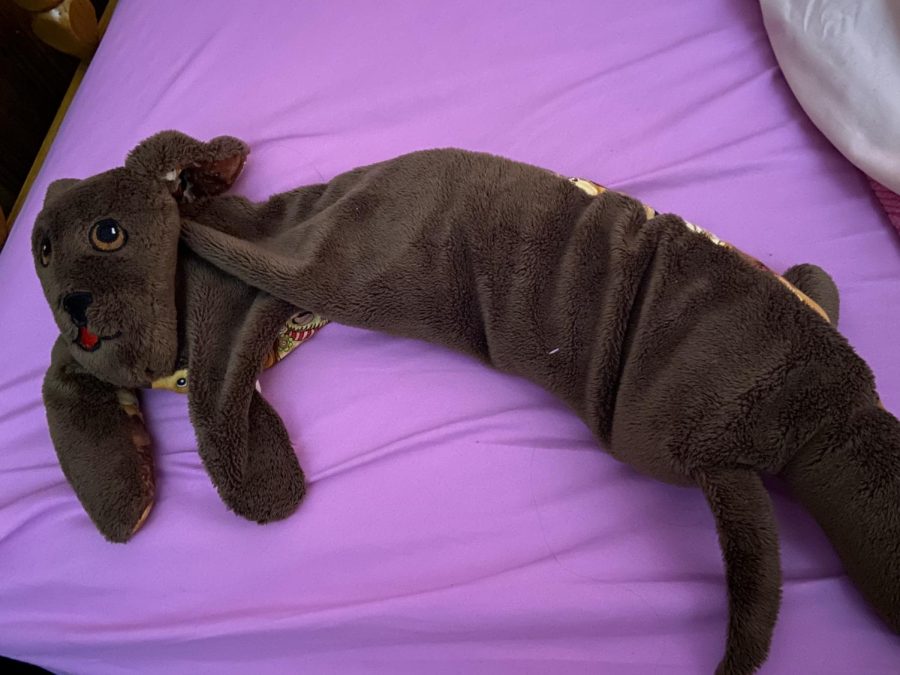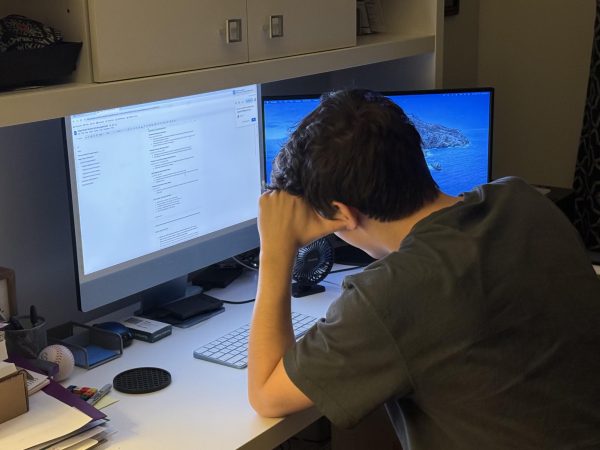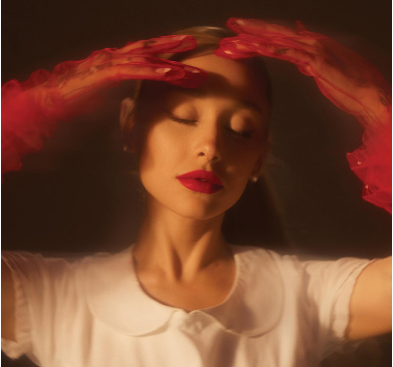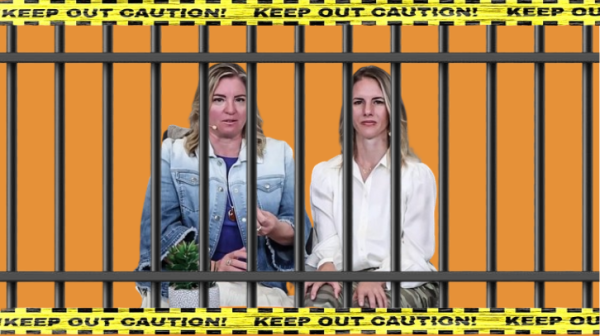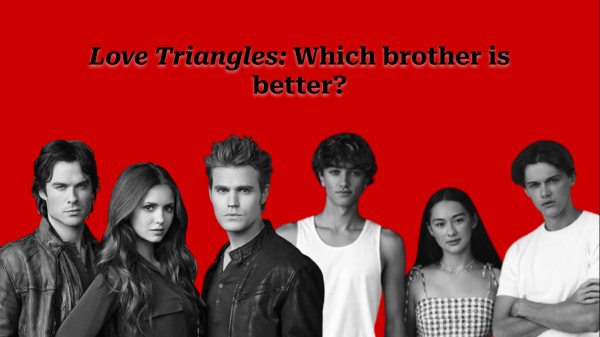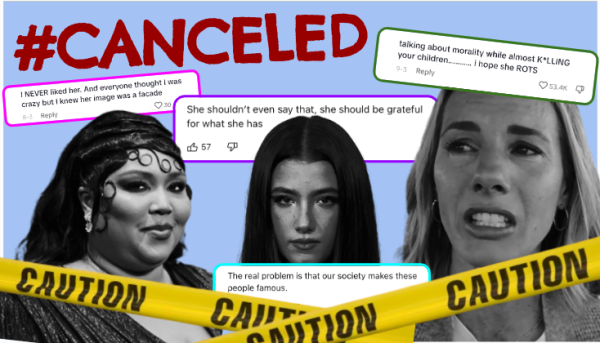Occupational Therapy: more than just “fun and games”
Coco is an at least 10 year old weighted stuffed animal owned by Alexis Simmerman. When placed on a person’s lap, they help calm them down and create a motor input for the more hyper of body.
April 14, 2022
Occupational therapy isn’t very well understood. Most think that it’s meant for people with disabilities, that it’s the same as physical therapy, and not much more. Not many people know about what they actually do, or what their real purpose is.
Some people think that occupational therapy is merely just playing games and arts and crafts. However, it’s actually meant to help build life skills to allow a person with a disability to live independently.
Having ADHD and autism, I had the privilege of going to an occupational therapist myself back when I was younger, and I can confidently say that I wouldn’t be as composed as I am now without it.
Occupational therapy is meant to help physical, sensory, or cognitive skills that might be a bit more complicated for someone. It’s not just for old people, but for people of all ages to help them with daily struggles. It’s a tool to help people like me deal with emotional, social, or physical barriers in development, and can help us learn to better navigate daily life.
When I went, I was in early elementary school, and was very likely to wander away during class. And my sensory sensitivity was certainly another thing that needed to be addressed.
I never really understood what these sessions were because I was a kid who couldn’t really understand what the term occupational therapy was. In my mind, I saw these sessions as sort of like a play date with the therapist where we would do routine things and they would challenge me to get better with these tasks.
The difference between occupational therapy and physical therapy is that physical therapists cope more with pain and patients who are lacking range of motion, strength, or endurance. Occupational therapists focus more on the activity that a person needs to do, and how they will do that successfully.”
— Melissa Rios
According to Melissa Rios, FCPS Occupational therapist for 22 years, “In school we would focus more on your academics, if you were having trouble using the classroom tools. Or if it was more environmental, are you processing your sensory system in order to focus? We also work on your social participation and self care skills. Making sure you can change in and out of your gym clothes, be able to go to the bathroom on your own. We can also help with transitioning and work skills. So after high school you can pick a career and are able to transition into that career successfully.”
The visits I experienced were generally divided into two, maybe three sessions, each one located in a different area of the clinic. Each session had different subject matter, and the rooms were catered to each of those subjects.
The first room we generally went to was the trampoline room, or at least, that was what I called it. This was a room with colorful padded areas, a bunch of balls, balloons, and I think even a trampoline. This is the room where we would do more active activities, such as playing games with the balls.
“We also help to improve eye hand coordination. So you are able to use your visual system and motor system to help them work together in order to interact with the world around them,” Mrs Rios said.
I think this is also why I like playing with balloons.
The next session was yoga. I think this was in order to help me control and calm my energy.
The final session was probably my favorite, because this was the one where did activities that were more creative or intellectually stimulating.
In this room, they helped me develop coping skills such as being the teacher’s helper in order to help me deal with my need to move. Weighted stuffed animals were introduced to me as a coping mechanism to calm myself and my nervous system down and keep me in place. I even still have my weighted stuffed animal, which I know I got after my sister was born because it’s a chocolate lab. They work in the same way as a weighted blanket, to give a frame of reference.
“The weighted materials that we use for students children with autism, is to help those children have that motor input and a calming effect. Sometimes with autism you have a limited body awareness, and you’re not quite sure where your body is in space, so the weighted materials allow you to have that input where you can sit for longer periods of time and to feel calm,” Mrs Rios said.
Another thing we did in that room was determine my sensory sensitivity, and help me learn how to cope with those sensitivity. They determined that my taste sensitivity was to avoid certain textures, the prime example being zucchini. My touch sensitivity is much like this as well, as I love smooth and soft surfaces I can run my hand over, but I hate textures that are rough and coarse.
Anyone who knows me and my noise canceling headphones is most familiar with would be my sound sensitivity.
I hate being in loud environments, but I think that it’s a bit more complicated than that. I’m much more receptive to sounds that follow a kind of harmony. However, sounds that are more of discord are actively triggering to my sensitivity, and they are generally very unpleasant–the cafeteria is a prime example of a discordant sound.
To combat this, the therapist first decided to try music therapy with me. It was basically homework to listen through a playlist of music a certain amount of time each day. Nowadays, when I have my own headphones on and listening to music that I like, music that generally has a strong beat and energy to it, you can bet that I’m turning it all the way up.
When the sound therapy didn’t work, that was when they recommended earmuffs to me, in order to combat the noise sensitivity. It would lessen my sensory input, and provide a calming stimulus whenever things got loud. To this day, I still wear earmuffs, and I’m in complete disarray without them.
Another thing we did was make bracelets or other jewelry.
“That also helps define motor skills that you need to use with classroom tools. Holding a pencil or holding a pen. We help develop those fine motor skills,” Mrs Rios said.
They were meant to be a kind of stimming toy for me, something my fingers could fiddle with. These were made out of elastic and colorful beads, so they were stretchy, with many ways to play with them as I deemed fit, and also build fine motor skills. This sort of became a side hobby for me, and even at home I used to make them all time so that I would have something for my fingers during class. Recently, that purpose has been filled by my necklace, but I still remember those bracelets fondly.
Another thing we commonly did was tracing on a lightboard. This was meant to help me with my handwriting. In the start, I would often trace letters or words from a pre existing document onto another piece of paper using the lightboard, basically tracing how I should write. However, I would also trace coloring book pages onto separate pieces of paper as well. I could replicate a page with fairly decent accuracy. While I do need to type nowadays as my handwriting is still horrible, it’s not nearly as bad as before.
At the end of every session came my favorite activity, an app called Frozen Free Fall. And yes, I am talking about the over-saturated Disney hit. The movie had just come out, the colors were pretty, and I already had a love for Bejeweled, so sue me. It was a match three game with different variables and challenges involved in each level. It was what taught my brain to problem solve. Bejeweled was a similar game, but Freefall forced me to plan, develop tactics, predict how certain moves would benefit or hinder my progress, figure out what was important to my objective and how I could use the tools I was given to get the best possible outcome. Even now, I still have this game on my phone, and it’s become one of the only games I have on my phone with a fairly impressive progress rate, if I do say so myself.
I did stop going sometime perhaps around middle school. That’s the goal of a good therapist–to make sure the patient doesn’t need any more help.
It wasn’t about teaching me to just deal with my struggles like normal people do, and it wasn’t about just playing with me. Everything I did there had an underlying purpose behind it that helped me learn to develop and cope with my circumstances in my own way. It was about learning what made me who I am, and developing ways to work around shortcomings. I’m not sure where I would be today without everything I learned there.
And occupational therapy as a profession is expected to grow at a 17% rate from 2020 to 2030, so there will likely always be a need for this incredibly important job.


